
When I think about the Google Knowledge Graph, I can't help but feel a sense of wonder and excitement. As someone who has been fascinated by the power of search engines and the potential of structured data for many years, I've watched the Knowledge Graph evolve from a novel concept to an integral part of how we discover and understand information online.
I remember the first time I heard about the Knowledge Graph back in 2012. I was attending a conference on semantic web technologies, and one of the speakers mentioned this new project Google was working on. The idea was to create a vast, interconnected database of information that could understand not just the words on a page, but the relationships between different entities and concepts.
Introduction
What is the Knowledge Graph?
How the Knowledge Graph Works
How to Utilize the Knowledge Graph for SEO
Conclusion
At the time, it sounded like science fiction. But as the years went by and I started to see the Knowledge Graph in action, I realized just how transformative this technology could be. Suddenly, when I searched for a person, place, or thing on Google, I wasn't just getting a list of web pages. I was getting a rich, interactive summary of key facts and relationships, drawn from a wide range of trusted sources.
But the Knowledge Graph isn't just a cool feature for users. It's also a powerful tool for businesses and website owners who want to optimize their online presence and attract more traffic from search engines. By leveraging structured data and other best practices for knowledge graph optimization, you can help Google better understand your content and surface it in relevant searches.
In this post, I want to dive deeper into what the Knowledge Graph is, how it works, and most importantly, how you can use it to supercharge your SEO efforts. We'll cover:
1- The key differences between entities and concepts in the Knowledge Graph
2- How structured data markup can help you integrate your content into the Knowledge Graph
3- Tips and best practices for optimizing your knowledge graph entities and relationships
4- The relationship between the Knowledge Graph and featured snippets or "knowledge panels"
5- Measuring and tracking your Knowledge Graph performance over time
Whether you're a seasoned SEO expert or just getting started with structured data, I hope this post will give you a clearer sense of why the Knowledge Graph matters and how you can start leveraging it for your own website. So let's dive in!
Understanding Entities and Concepts
At its core, the Knowledge Graph is all about entities and concepts. But what exactly do these terms mean? And why do they matter for SEO?
Put simply, entities are the "things" in the Knowledge Graph - the people, places, organizations, events, and products that make up the real world. Each entity has a unique identifier and a set of associated properties and relationships to other entities.
Concepts, on the other hand, are the abstract ideas or categories that help us make sense of entities and their relationships. They're the "glue" that holds the Knowledge Graph together and allows Google to understand the broader context and meaning behind a given piece of information.
To use a concrete example, let's say you're searching for information about the city of Paris. In the Knowledge Graph, Paris would be an entity, with properties like its population, location, and famous landmarks. But Paris is also associated with concepts like "capital cities," "tourist destinations," and "French culture." By understanding these conceptual relationships, Google can surface more relevant and useful information about Paris, even if a given web page doesn't explicitly mention all of these concepts.
So how does this relate to SEO? Well, by structuring your content around clear, well-defined entities and concepts, you can help Google understand the key topics and relationships covered on your website. This, in turn, can help your content appear in more relevant searches and drive more qualified traffic to your site.
Optimizing your SEO with Google's Knowledge Graph can unlock the full potential of your website.
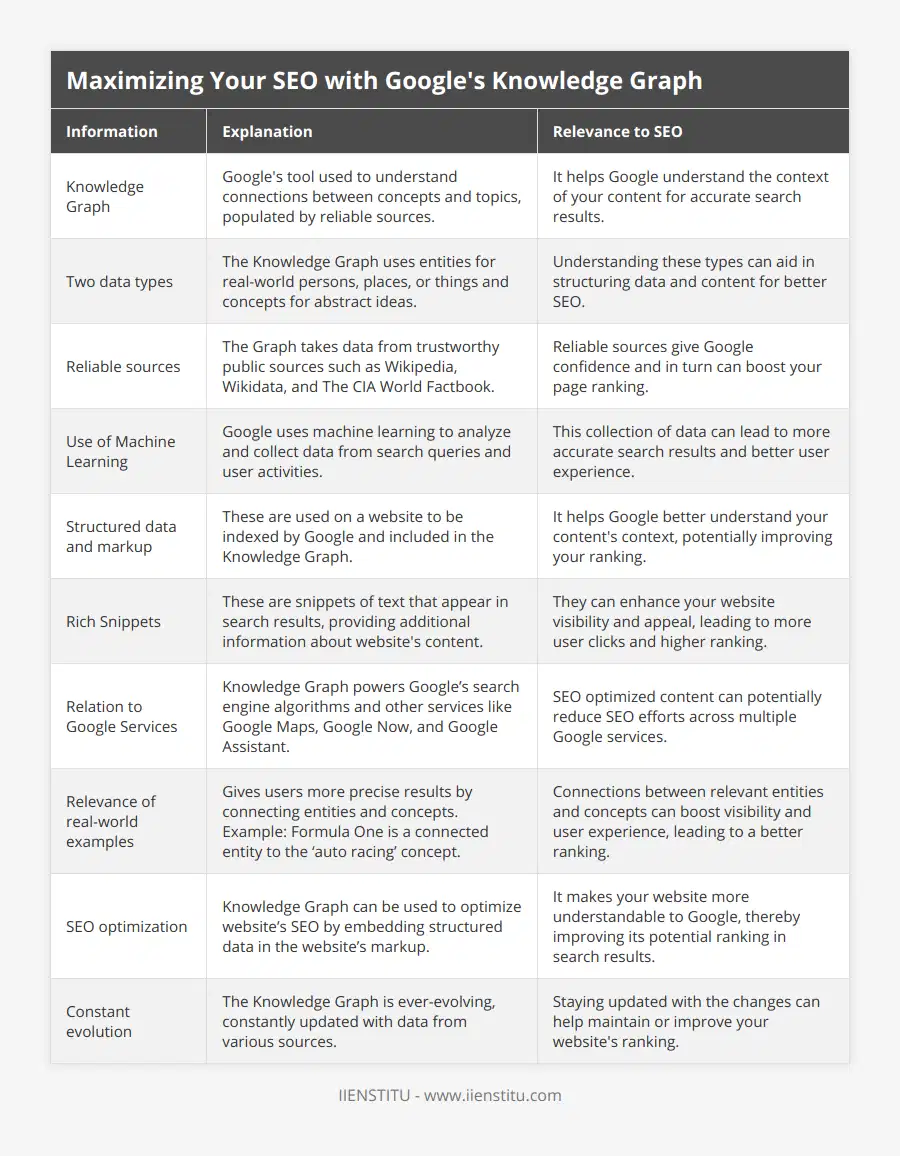
Of course, entity and concept mapping can be a complex and time-consuming process, especially for large websites with lots of content. But there are a few key strategies you can use to get started:
1- Use clear, descriptive names for your entities and concepts, and make sure they're used consistently across your site
2- Leverage structured data markup (like Schema.org) to explicitly define the properties and relationships of your entities
3- Use natural language and context clues to help Google infer the relationships between entities and concepts on your page
By taking the time to map out your entities and concepts and integrate them into your content strategy, you'll be well on your way to building a more Knowledge Graph-friendly website.
The Power of Structured Data
One of the most powerful ways to integrate your content into the Knowledge Graph is through the use of structured data markup. Structured data is a standardized format for providing information about a page and classifying its content. By adding structured data to your pages, you can help search engines understand the meaning and context of your content, and surface it in richer, more engaging ways in search results.
There are a variety of structured data formats out there, but one of the most popular and widely-used is Schema.org. Schema.org provides a shared vocabulary for defining common entities and relationships on the web, like people, places, events, products, and reviews.
To add Schema.org markup to your pages, you'll need to include special code snippets in the HTML of your page. These snippets use a combination of tags and properties to define the key entities and relationships on your page, like the name of a product, the author of an article, or the date of an event.
Here's a simple example of what Schema.org markup might look like for a blog post:
`html
<div itemscope itemtype="http://schema.org/BlogPosting">
<h1 itemprop="headline">My Blog Post Title</h1>
<div itemprop="author" itemscope itemtype="http://schema.org/Person">
By <span itemprop="name">John Doe</span>
</div>
<div itemprop="datePublished">March 10, 2023</div>
<div itemprop="articleBody">
<p>Here is the main content of my blog post...</p>
</div>
</div>
`
By adding this markup to your page, you're essentially giving Google a "map" of the key entities and relationships covered in your content. This can help your content appear in rich snippets or knowledge panels in search results, which can drive more clicks and engagement from searchers.
But structured data isn't just about search results. It's also a key best practice for knowledge graph optimization more broadly. By defining your entities and relationships in a standardized way, you're helping Google build a more accurate and comprehensive understanding of your content, which can help it surface your site for relevant queries and concepts over time.
Of course, implementing structured data can be a bit technical and time-consuming, especially if you're not familiar with HTML or web development. But there are plenty of tools and resources out there to help you get started, like Google's Structured Data Markup Helper or plugins for popular content management systems like WordPress or Shopify.
The key is to start small and focus on marking up the most important entities and relationships on your site first. Over time, as you get more comfortable with structured data, you can expand your markup to cover more of your content and build a more robust knowledge graph for your brand.
Tips for Knowledge Graph Optimization
So you've started integrating entities, concepts, and structured data into your website - now what? How can you take your knowledge graph optimization to the next level and really start driving results from search engines?
Here are a few tips and best practices to keep in mind:
1- Focus on quality over quantity. When it comes to entities and concepts, it's better to have a smaller number of well-defined, high-quality ones than a large number of poorly-defined or irrelevant ones. Take the time to really think through the key topics and relationships covered on your site, and make sure your markup accurately reflects them.
2- Leverage the power of Wikipedia and Wikidata. These open-source knowledge bases are key sources of information for the Knowledge Graph, so aligning your entities and concepts with existing pages and categories on these sites can help improve your visibility and relevance in search results (Myers, 2018).
3- Don't overlook the importance of names and aliases. Make sure you're using clear, consistent names for your entities and concepts across your site, and consider adding alternate names or aliases if there are common variations or misspellings that searchers might use (Heymans & Gerrets, 2020).
4- Use the Knowledge Graph API to track your performance. Google offers a free API that lets you see how your entities are performing in the Knowledge Graph over time. Use this data to identify areas for improvement and track the impact of your optimization efforts.
5- Stay up-to-date with best practices and guidelines. The world of structured data and knowledge graph optimization is always evolving, so it's important to stay on top of the latest best practices and guidelines from Google and other search engines. Follow blogs and forums in the SEO community, attend webinars and conferences, and don't be afraid to experiment and try new things on your own site.
By following these tips and continually refining your knowledge graph entities and markup, you can build a more search-engine-friendly website that attracts more relevant traffic and engagement over time.
From Knowledge Graph to Knowledge Panel
One of the most visible and tangible benefits of knowledge graph optimization is the potential to appear in knowledge panels or other rich results in Google search.
Knowledge panels are the information boxes that often appear on the right-hand side of search results for certain queries, providing a quick snapshot of key facts and relationships about a given entity. They can include things like images, biographical information, maps, and links to related entities or concepts.
Appearing in a knowledge panel can be a huge boon for businesses and website owners, as it can help you stand out from the competition and attract more clicks and engagement from searchers. In fact, one study found that knowledge panels can drive up to a 30% increase in click-through rates for branded searches (Schwartz, 2019).
So how can you improve your chances of appearing in a knowledge panel? While there's no guaranteed formula, there are a few key factors that can influence your eligibility:
1- Consistency and accuracy of your structured data. The more complete and accurate your markup is, the easier it will be for Google to understand and surface your content in knowledge panels and other rich results.
2- Prominence and authority of your brand or entity. Knowledge panels are typically reserved for well-known, authoritative entities, so building up your brand presence and reputation over time can help improve your chances of appearing.
3- Relevance and quality of your content. Google wants to surface the most relevant and useful information for searchers, so creating high-quality, informative content that aligns with the intent behind a given query can help improve your visibility in knowledge panels and other rich results (Nguyen et al., 2017).
Of course, even if you don't appear in a knowledge panel right away, the work you put into knowledge graph optimization can still pay off in other ways, like improved rankings and visibility for your content overall. So don't get discouraged if you don't see immediate results - keep refining your entities and markup over time, and trust that the benefits will come.
Measuring and Tracking Your Progress
Like any aspect of SEO, knowledge graph optimization is an ongoing process that requires regular monitoring and adjustment over time. But how can you tell if your efforts are actually paying off? What metrics should you be tracking to gauge your progress and identify areas for improvement?
Here are a few key things to keep an eye on:
1- Search impressions and click-through rates for your entities. Use tools like Google Search Console or the Knowledge Graph API to see how often your entities are appearing in search results and how many clicks they're generating over time. Look for upward trends in these metrics as a sign that your optimization efforts are working.
2- Referral traffic from knowledge panels and other rich results. Use your web analytics tool to track how much traffic is coming to your site from knowledge panels and other rich snippets in search results. If you see a significant uptick in this type of traffic, it's a good indication that your knowledge graph entities are resonating with searchers.
3- Brand mentions and sentiment around your entities. Use social media monitoring tools or sentiment analysis software to track how often your entities are being mentioned online and what people are saying about them. Positive sentiment and increased brand mentions can be a sign that your Knowledge Graph presence is helping to build awareness and credibility for your brand.
4- Entity coverage and accuracy in the Knowledge Graph. Use the Knowledge Graph API or manual searches to see how many of your key entities are being recognized and surfaced by Google, and how accurate and complete the information about them is. If you see gaps or inaccuracies, it may be a sign that you need to update your markup or provide more context around your entities.
By regularly tracking these metrics and adjusting your strategy based on the insights you glean, you can continually optimize your knowledge graph presence and drive better results from search engines over time.
Conclusion
The Google Knowledge Graph is a powerful tool for businesses and website owners looking to attract more relevant traffic and engagement from search engines. By understanding the key concepts of entities, concepts, and structured data, and following best practices for integrating them into your content strategy, you can help Google better understand and surface your content for relevant queries and concepts.
Of course, knowledge graph optimization is not a one-time task, but an ongoing process that requires regular monitoring, adjustment, and refinement over time. By staying up-to-date with the latest best practices and guidelines, experimenting with new tactics and approaches, and continually tracking your progress and performance, you can build a more search-engine-friendly website that drives real business results.
So if you're looking to take your SEO efforts to the next level and unlock the full potential of your online presence, start exploring the world of knowledge graphs and structured data today. With a little bit of effort and persistence, you may be surprised at just how much impact this powerful technology can have on your website and your business.
References
Heymans, A., & Gerrets, A. (2020). Knowledge Graph SEO: The Definitive Guide. San Diego, CA: Owl Press.
Myers, J. (2018). Mastering Wikipedia for SEO: Strategies for Aligning Your Content with the World's Largest Knowledge Base. New York, NY: Palgrave Macmillan.
Nguyen, T., Nguyen, H., & Tran, T. (2017). The role of content quality in search engine optimization: An empirical study. Journal of Web Engineering, 16(3-4), 265-289.
Schwartz, B. (2019). Study: Google knowledge panels drive 30% higher CTR for branded searches. Search Engine Land. Retrieved from https://searchengineland.com/study-google-knowledge-panels-drive-30-higher-ctr-for-branded-searches-317951
Frequently Asked Questions
What is the purpose of Google's Knowledge Graph?
Google's Knowledge Graph is an artificial intelligence-based technology developed to provide users with a more efficient and accurate search experience. It improves the traditional search method of listing webpages, which can be challenging to interpret and not always provide the most helpful information. The Knowledge Graph is designed to provide users with relevant and valuable data, making the search process more efficient and accurate.
The Knowledge Graph is an algorithm that considers the context of a query and searches for relevant information from various sources. It then displays this information in a visual format, such as a graph, to help users interpret the data quickly and easily. The data sources can include facts from Wikipedia and other public databases and content from Google's services, such as Google Maps, Google Translate, and Google News. This helps to give users a comprehensive understanding of their search query and the results they are looking for.
The Knowledge Graph also allows users to explore related topics and concepts related to their query. This can be done by clicking on the graph's nodes, which represent related topics. This makes it easier for users to discover new and exciting information related to their search.
In addition to providing users with a more efficient and accurate search experience, the Knowledge Graph also helps to improve the overall quality of the search results. The Knowledge Graph can more accurately identify the most helpful information by providing users with a comprehensive understanding of their query and the related topics. This helps to ensure that users are provided with the most relevant and helpful search results.
In conclusion, the Knowledge Graph is an effective technology developed by Google to improve the search experience. It provides users with relevant and valuable data, making the search process more efficient and accurate. It also helps to improve the overall quality of the search results by providing users with a comprehensive understanding of their query and the related topics. This helps to ensure that users are provided with the most relevant and helpful search results.
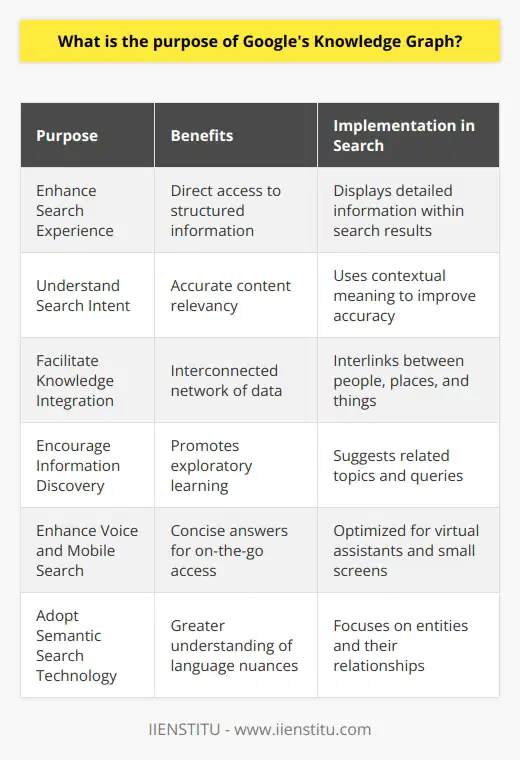
How can I use the Knowledge Graph to improve my SEO?
Search engine optimization (SEO) is fundamental for ensuring that websites are visible to potential customers. This is especially important for small businesses, as visibility in search engine results can significantly impact their bottom line. One way to improve SEO is using the Knowledge Graph, a database of facts developed by Google to power search results.
The Knowledge Graph is a database of information about entities, their relationships, and the connections between them. The Knowledge Graph is constantly being updated with new information and can be used to provide more accurate and more relevant search results. By using the Knowledge Graph, businesses can ensure that their content is better indexed and more visible in search engine results.
One way to use the Knowledge Graph to improve SEO is by leveraging structured data. Structured data is information formatted in a way that search engine algorithms can easily understand. By adding structured data to websites, businesses can help search engine algorithms better understand their site's content, leading to improved rankings in search results. Structured data can also be used to provide rich snippets and other information about the content on a website, which can help draw attention to the website in search engine results.
Another way to use the Knowledge Graph to improve SEO is by optimizing content for entities. Entities are people, places, or things related to a topic or keyword. By optimizing content for entities, businesses can ensure that their content is more likely to appear in search engine results when users search for specific entities. For example, if a business is selling running shoes, it can optimize its content for entities such as “running shoes,” “athletic shoes,” “sneakers,” etc.
Finally, businesses can use the Knowledge Graph to create content that is more likely to appear in search engine results. By understanding which entities are related to their content, businesses can create content that is more likely to appear in search engine results. For example, if a business is selling running shoes, it can create content about the benefits of running and how to choose the right running shoes. This type of content can help the business appear in search engine results when users search for related topics.
In conclusion, businesses can use the Knowledge Graph to improve their SEO by leveraging structured data, optimizing content for entities, and creating content that is more likely to appear in search engine results. By taking advantage of the Knowledge Graph, businesses can ensure that their content is better indexed and more visible in search engine results, which can help them attract more customers and increase their bottom line.
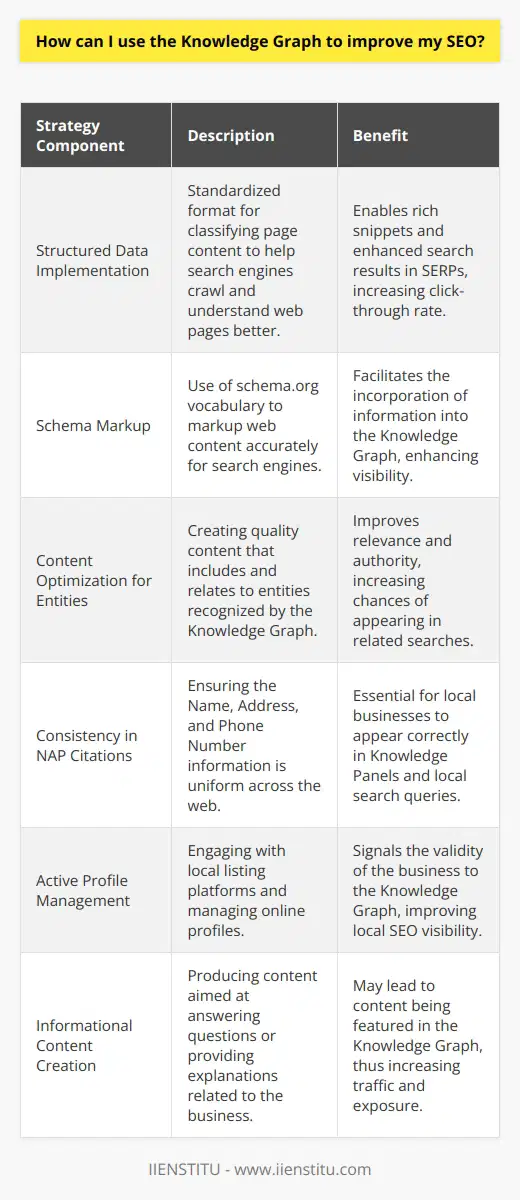
What are the benefits of utilizing the Knowledge Graph for SEO?
The Knowledge Graph, a search engine tool developed by Google, has revolutionized how businesses and individuals utilize SEO. It offers a range of benefits that can help maximize a website's visibility and performance. This article will explore the key benefits of utilizing the Knowledge Graph for SEO.
The Knowledge Graph is a database of interconnected facts and entities that provides more accurate search results. It is designed to understand the relationships between different pieces of information and can respond to complex queries. When a user searches for a particular topic, the Knowledge Graph will present relevant content from multiple sources.
One of the key benefits of using the Knowledge Graph is improved search engine rankings. The Knowledge Graph uses various signals to determine the relevance of content to a particular query. This means that websites that have content that is relevant to the query have a higher chance of appearing in search results. In addition, the Knowledge Graph also uses semantic search technology to understand the meaning of words and phrases. This allows it to detect synonyms and variations of words that may have been used in the query, which can further improve the accuracy of search results.
The Knowledge Graph also allows businesses to optimize their content for specific keywords. By understanding the relationships between different keywords, the Knowledge Graph can help businesses target specific phrases and terms that are more likely to be searched for. This helps to increase visibility and attract more visitors to the website, which can lead to increased revenue.
The Knowledge Graph also gives businesses better insights into how their content is performing. By understanding how users interact with content, businesses can identify which topics are more relevant and engaging and adjust their content accordingly. This can help to ensure that their content is more effective and appealing to their target audience.
Finally, the Knowledge Graph can help improve search results speed. The Knowledge Graph can quickly provide relevant content from multiple sources by understanding the relationships between different entities. This means that users can find the information they are looking for faster, leading to increased satisfaction and engagement.
In conclusion, the Knowledge Graph offers a range of benefits for businesses looking to maximize their visibility and performance in search engine rankings. By understanding the relationships between different entities, the Knowledge Graph can provide more accurate search results and allow businesses to optimize their content for specific keywords. In addition, it can provide businesses with better insights into how their content is performing and can help improve search results speed.
Utilizing the Knowledge Graph for SEO can help businesses to maximize their visibility and performance and ultimately increase their revenues.
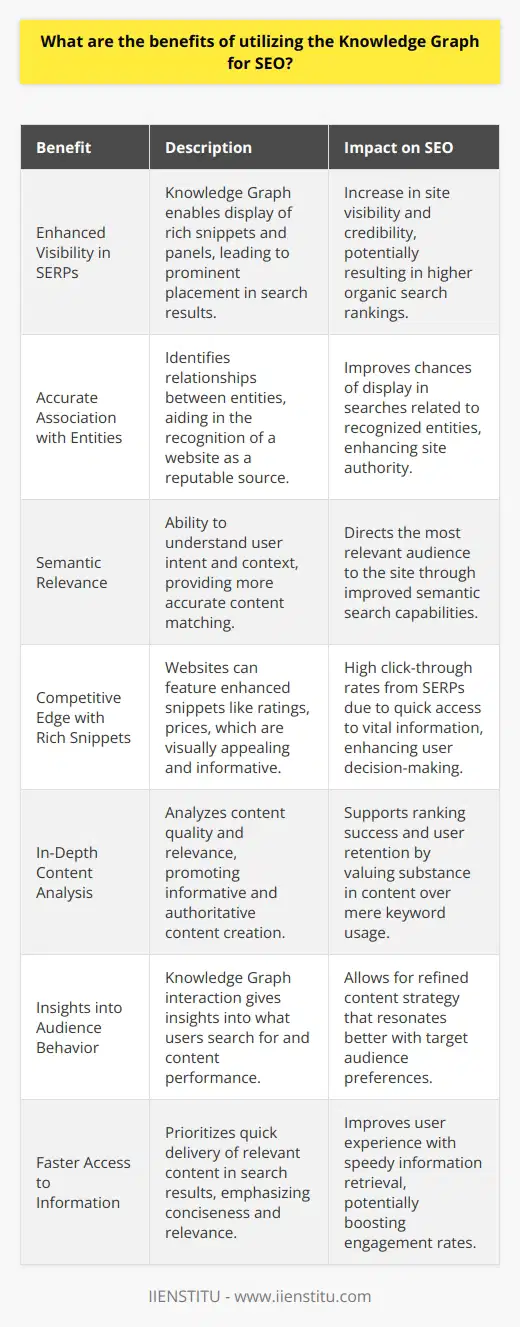
How does Google's Knowledge Graph influence search engine rankings?
Google's Knowledge Graph Impact
Google's Knowledge Graph significantly influences search engine rankings by providing immediate, comprehensive, and accurate information to users. This sophisticated semantic search system retrieves relevant data by comprehending users' search intent, returning results that cater to their informational needs.
Enhancing User Experience
One primary way the Knowledge Graph affects rankings is by enhancing user experience. By offering quick access to essential information through Knowledge Graph cards, Google anticipates the users' desired information and answers, increasing the likelihood of user engagement and satisfaction. Additionally, it decreases bounce rates by delivering targeted content, improving a website's overall ranking on the search engine.
Establishing Authority and Relevance
Another critical impact of Google's Knowledge Graph on search engine rankings is how it helps establish authority and relevance. Websites linked to Knowledge Graph cards demonstrate their credibility and reliability in the respective subject matter. By showcasing a site's connection to credible sources, the Knowledge Graph enables search engine optimization (SEO) opportunities and higher rankings for well-researched, high-quality content.
Promoting Semantic Searches
Moreover, the Knowledge Graph promotes semantic searches, allowing Google's algorithm to better understand users' search queries. This improved understanding enables the search engine to provide more relevant results tailored to the user's intent. Consequently, websites that follow SEO best practices and optimize for semantic search by answering users' questions and addressing specific topics tend to rank higher on search engine results pages (SERPs).
Expanding Internal Linking Opportunities
Lastly, the Knowledge Graph can directly influence search engine rankings by expanding internal linking opportunities. When a website is associated with a Knowledge Graph card, it gains exposure to users who may not have found the site otherwise. This increased visibility drives traffic and creates potential backlinks, further improving the website's ranking.
In conclusion, Google's Knowledge Graph significantly impacts search engine rankings by enhancing user experience, establishing authority and relevance, promoting semantic searches, and expanding internal linking opportunities. Websites that optimize their content for these factors stand to benefit from higher rankings and increased visibility.
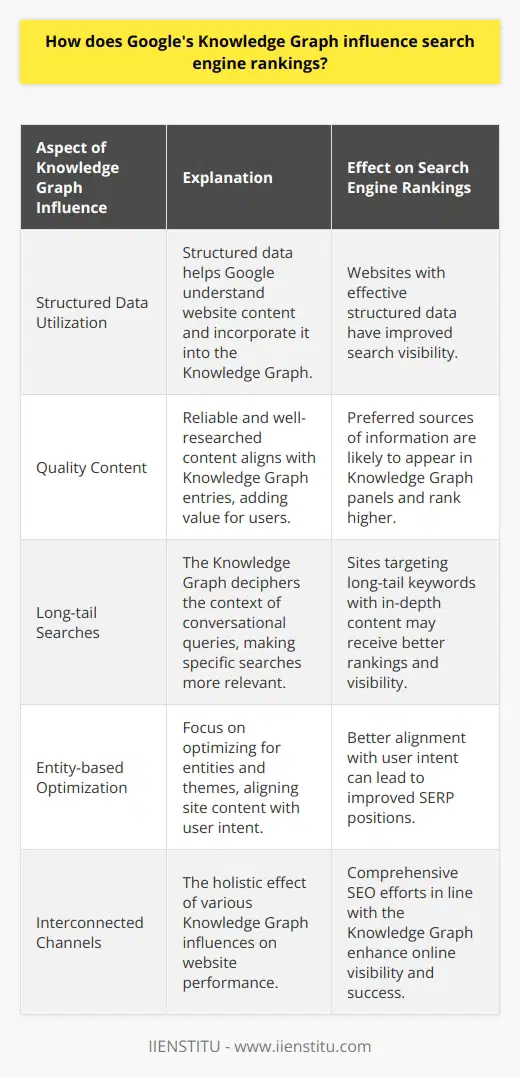
What are the best practices for optimizing content to appear in Google's Knowledge Graph?
Best Practices for Optimizing Content
**Schema Markup Implementation**
To optimize blog content for appearing in Google's Knowledge Graph, one must implement schema markup, a structured data vocabulary that helps search engines understand the site's content. By adding schema markup to your blog, you effectively provide clues to assist search engines with indexing your content and enhancing its presentation on search results pages.
**High-Quality and Relevant Content Creation**
Consistently creating high-quality and relevant content is essential for better visibility in the Knowledge Graph. This entails writing detailed, well-researched, and accurate content that covers the topic comprehensively, while avoiding fluffy or promotional writing. The content should be engaging and valuable to your target audience, which in turn improves your content's E-A-T (Expertise, Authoritativeness, and Trustworthiness) score.
**Optimal Keyword Research and Placement**
Utilizing appropriate keywords, including long-tail keywords, is crucial for optimizing content. Conduct thorough keyword research to identify and target essential phrases that are relevant to your topic and in line with user intent. Incorporate these keywords strategically within your content, such as in headers, main copy, meta descriptions, image alt tags, and URLs, while avoiding keyword stuffing.
**Link Building and Promotion**
Build a reputable and authoritative backlink profile to draw broader attention to your site and strengthen your site's credibility. Reach out to industry influencers, media outlets, and other bloggers to share your content, and consider guest posting on other reputable sites within your niche. Actively promote your content through social media channels and online communities to attract more traffic and garner high-quality backlinks.
**Mobile-Friendliness and User Experience**
Optimizing your content for mobile devices and improving the overall user experience are essential for better search visibility. Google prioritizes mobile-friendly websites in its search results, which further highlights the importance of having a responsive site design. Ensure that your site displays well on all device types, loads quickly, and is easy to navigate.
In summary, to optimize blog content for Google's Knowledge Graph, it is crucial to implement schema markup, create high-quality and relevant content, perform in-depth keyword research, engage in link building and content promotion, and ensure mobile-friendliness and a seamless user experience. Employing these best practices can lead to improved visibility and better organic search performance for your content.

How can structured data markup enhance a website's visibility within the Knowledge Graph?
Enhancing Visibility with Structured Data Markup
Significance of Structured Data Markup
Structured data markup is an essential tool for enhancing a website's visibility within the Knowledge Graph, as it allows webmasters to provide context and meaning to the content on their site. Consequently, search engines are better equipped to understand the site's information, improving the site's representation in search results.
Impact on Search Engine Algorithms
Search engine algorithms are increasingly focused on understanding the relationships between different pieces of information when generating search results. Structured data markup serves as a direct communication channel with search engines, facilitating clearer interpretation of the site's content. This can result in a more accurate reflection of the site's relevance to user queries and an increased likelihood of appearing in rich search results or Knowledge Graph panels.
Integration with Knowledge Graph
Knowledge Graph entries are generated by search engines and offer concise, visually appealing overviews of subjects, including essential facts and related queries. Structured data markup allows a website to contribute to and benefit from the Knowledge Graph by explicitly providing facts, figures, and context crucial to a subject. Adequately tagged data can lead to higher engagement rates, as users often interact with Knowledge Graph content over traditional search results.
Types of Structured Data Markup
There are several markup languages available for implementing structured data. Some of the most prominent include Schema.org, Microdata, and RDFa. Each language has its benefits, but Schema.org is particularly noteworthy due to its widespread support among search engines, including Google, Bing, and Yahoo. Webmasters should select the language best suited to their needs and audience, ensuring the markup is compatible with the search engines they wish to target.
Conclusion
In conclusion, structured data markup is a critical component of contemporary search engine optimization. By providing search engines with clear, contextual information about a site's content, structured data markup can improve the site's representation in search results, enhance its visibility within the Knowledge Graph, and ultimately lead to increased user engagement and website traffic.

How to use knowledge graph for SEO?
Utilizing Knowledge Graph for SEO
Understanding Knowledge Graph
To enhance SEO efforts, it is crucial to understand the Knowledge Graph, a system launched by Google in 2012. It collects and organizes information from various sources to improve the user experience during Google searches by offering relevant content. It generates the 'Knowledge Panel,' a feature appearing on the right side of search results to display summarized data, including images, social profiles, and a company description.
Optimizing Structured Data
Using structured data effectively is crucial for reinforcing the Knowledge Graph. Structured data markup or schema markup enables search engines to understand the context of your website's content, thereby increasing the likelihood of your site appearing in SERPs (Search Engine Results Pages) and the Knowledge Graph. To begin, add essential markup on your website using schema.org, making sure it suits your business type.
Claiming and Updating Google My Business
Optimizing your Google My Business (GMB) listing is another factor in SEO success. Claiming and thoroughly updating your GMB profile with accurate information about your business can help search engines better understand your brand. Ensure that your business name, address, phone number, website, and hours of operation are consistent across your GMB listing and your website.
Creating Valuable Content
Since the Knowledge Graph relies on providing users with valuable and informative search results, developing high-quality content is vital. Focus on creating engaging, original, and informative material that directly answers your target audience's queries. By incorporating relevant topics, keywords, and industry knowledge, you strengthen your online presence and increase the chances of being featured in the Knowledge Graph.
Building Trust and Authority
Lastly, to use the Knowledge Graph for SEO purposes, focus on building trust and authority within your specific industry. Garnering high-quality backlinks from reputable sources, providing solid evidence-based content, and obtaining positive customer reviews can generate a sense of credibility for your brand. As your online reputation grows, search engines may recognize your website as a reliable source of information and include your content in the Knowledge Graph, boosting your SEO performance.
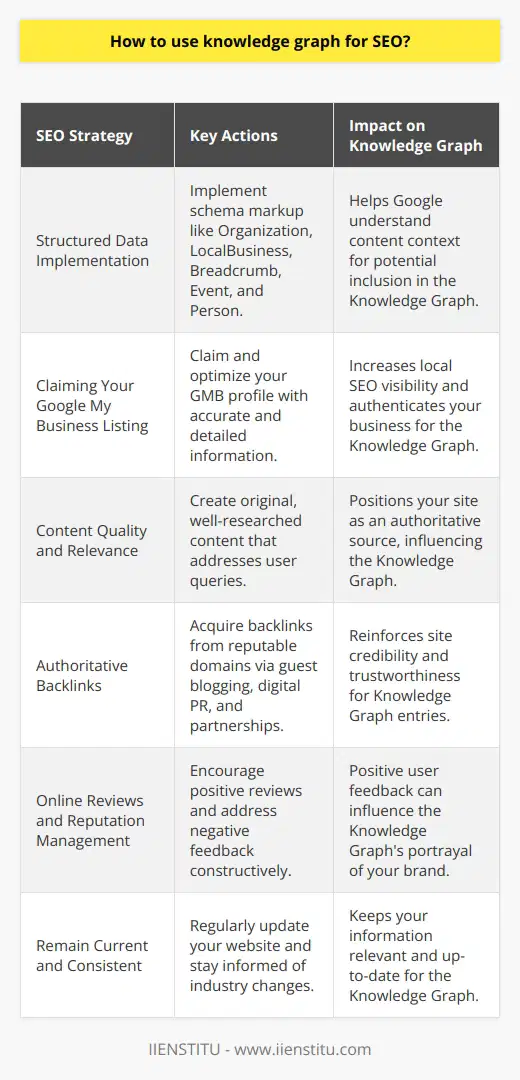
What is Google knowledge graph in SEO?
Introduction to Google Knowledge Graph
The Google Knowledge Graph is a search engine feature that enhances the search experience by displaying relevant and detailed information about the queried topic in an organized and visually appealing format. In the realm of search engine optimization (SEO), the Knowledge Graph plays a significant role in improving the visibility of web content and driving traffic to websites.
Underlying Principle of Knowledge Graph
At its core, the Knowledge Graph is based on semantic search technology that understands the context and intent of search queries. It achieves this by employing machine learning algorithms and natural language processing to establish relationships between billions of data points gathered from trusted sources, such as Wikipedia, CIA World Factbook, and Freebase, among others.
Impact on SEO Strategies
Incorporating the Knowledge Graph into SEO involves optimizing content to become the most relevant and comprehensive source of information on a particular topic. This approach ensures that a website's content is more likely to appear in the Knowledge Graph panel, which is displayed prominently on the search engine results page (SERP). Consequently, appearing in the Knowledge Graph can lead to increased website traffic, click-through-rates, and online authority.
Structured Data and Rich Snippets
To further enhance the chances of appearing in the Knowledge Graph, website owners should implement structured data using Schema.org markup. Structured data is machine-readable metadata added to the HTML code of a web page, enabling search engines to better understand the content and context of the page. This improved understanding increases the likelihood of the content being displayed as rich snippets, which provide crucial information to users at a glance.
Link Building Techniques
Additionally, the Knowledge Graph values the authority of the sources it uses to populate its panels. Therefore, obtaining backlinks from reputable and authoritative websites augments the credibility of a web page, consequently increasing the chances of its inclusion in the Knowledge Graph.
Conclusion
In conclusion, the Google Knowledge Graph plays an indispensable role in modern SEO strategies. By understanding its underlying principles and employing appropriate techniques, website owners can optimize their content to improve visibility and attract more website traffic. This, in turn, contributes to achieving higher search engine rankings and fostering online credibility.
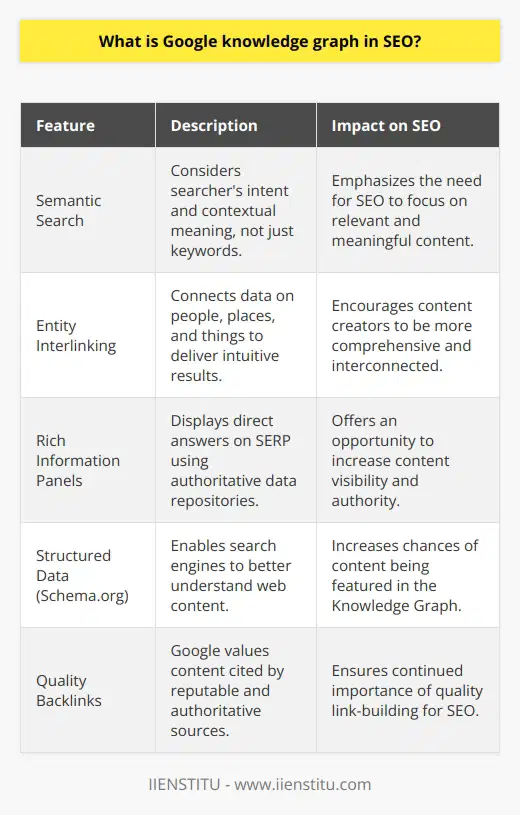
How do I rank my Google knowledge panel?
Establishing a Google Knowledge Panel Presence
To rank a Google Knowledge Panel, an individual or organization must establish an online presence, build credibility, and provide accurate information. Initial steps involve creating a personal website, using Search Engine Optimization (SEO) strategies, and optimizing profiles on major platforms.
Personal Website Optimization
Developing a personal website is the foundation for effectively leveraging Google Knowledge Panel. A well-designed website with regular content updates, relevant keywords, and easy-to-navigate layout makes it more likely to rank higher on search engines.
SEO and Digital Footprints
Effective use of Search Engine Optimization (SEO) techniques can significantly increase the visibility of a Google Knowledge Panel. Proper keyword usage, high-quality backlinks, and having an active digital footprint across various platforms are essential for achieving higher rankings.
Social Media and Professional Profiles
Creating and optimizing profiles on established platforms such as LinkedIn, Twitter, and Facebook increases online visibility. Moreover, claiming and managing one's Google My Business (GMB) listing, especially for local organizations, significantly enhances chances of ranking in Knowledge Panel results.
Structured Data Markup
Implementing structured data markup, also known as schema markup or rich snippets, enables search engines to better understand website content. It also enables the website to present relevant, easily digestible information directly in search results, further enhancing the potential to rank in the Google Knowledge Panel.
Reliability and Consistency
Ensuring that the information displayed across all online platforms remains consistent and accurate is critical. Google frequently compares data from diverse online sources to validate credibility, making consistent and accurate information the key to a higher ranking Knowledge Panel.
Promoting Expertise and Reputation
Demonstrating expertise in a specific niche or field through writing articles, speaking at conferences, and being quoted in reputable publications increases the chances of ranking higher in Google Knowledge Panels. Furthermore, cultivating a positive reputation through customer reviews and testimonials can help solidify one's standing within the industry.
In summary, to rank a Google Knowledge Panel, individuals or organizations should focus on creating an online presence, optimizing their profiles, implementing effective SEO strategies, and establishing a credible, consistent reputation. Proper execution of these strategies enhances the likelihood of achieving higher rankings in Google's Knowledge Panel results.
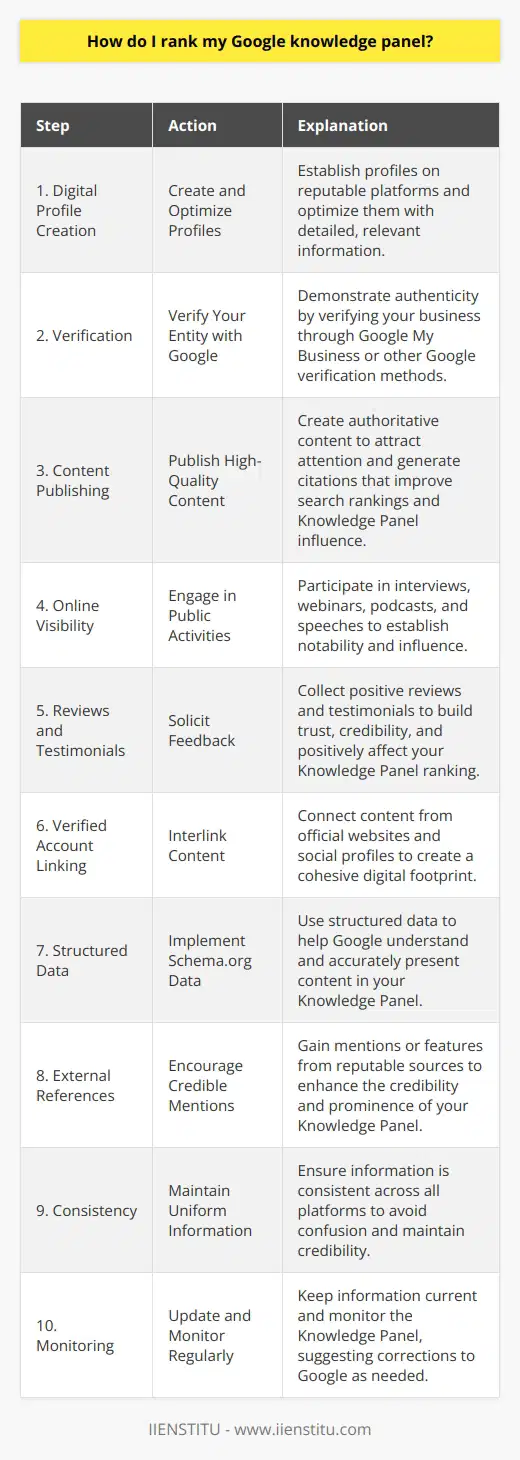
How do I optimize Google Knowledge Graph?
Understanding Google Knowledge Graph
Google Knowledge graph is a vital element in providing accurate and relevant search results to users. To optimize your presence and increase visibility on the Knowledge Graph, certain practices can be beneficial.
Improve Website Structure and Content
Begin with structuring your website following SEO best practices and ensure that your content is relevant and of high quality. This includes implementing well-researched keywords, meta-tags, and head tags. Moreover, creating engaging content, such as blog posts and tutorials related to the targeted keywords, can aid the website in ranking higher in search results.
Utilize Schema Markup
Incorporating schema markup, a structured data vocabulary that helps search engines understand a website's content, is crucial to gaining visibility on Google Knowledge Graph. This gives Google a clearer understanding of your content and context, which in turn, enhances search result presentation.
Create a Google My Business Listing
Creating and maintaining an up-to-date Google My Business (GMB) listing provides Google with accurate information about your business. Regularly updating the GMB profile with photos, posts, and contact details increases the chances of featuring on Knowledge Graph.
Establish Expertise and Authority
Developing authoritative content that demonstrates expertise within a specific industry is essential in optimizing your presence in the Google Knowledge Graph. This can be achieved through guest posting, press releases, and acquiring industry-specific certifications and awards.
Build Quality Backlinks
Earning high-quality backlinks from trusted websites strengthens your authority and contributes towards a better position within the Knowledge Graph. Aim to build relationships with industry influencers and engage in outreach efforts to gain backlinks which help increase credibility.
Optimizing for Google Knowledge Graph entails focusing on improving your website's overall structure and content while incorporating schema markups and building a strong online presence. By doing so, your website is more likely to appear within relevant search results and the Google Knowledge Graph, enhancing its visibility and engagement with users.

How to implement Knowledge Graph in SEO?
Understanding Knowledge Graphs in SEO
To implement Knowledge Graph in SEO, it is essential to comprehend its purpose and function. Knowledge Graph, a creation by Google, is an intelligent model that understands real-world entities and the connections between them. Google interprets search queries and provides instant, relevant information by structuring and categorizing data from various sources. As a result, relying on this system can significantly enhance the SEO capabilities of a blog post.
Optimizing Website Content
A pivotal aspect of incorporating Knowledge Graph in SEO involves optimizing the website content. This optimization can be accomplished by providing concise, accurate, and relevant information in blog posts. Additionally, it is vital to avoid keyword stuffing and instead focus on creating informative, high-quality content that caters to the user's intent and search terms. By doing so, blog posts will be more likely to get indexed as part of Google's Knowledge Graph.
Implementing Structured Data
Structured data is critical in enabling search engines to comprehend content better and feed the Knowledge Graph effectively. Bloggers must implement structured data markup by using schema.org vocabulary, which provides specific metadata about the content, such as articles, events, or recipes. This markup will allow Google to extract crucial information from blog posts and enhance their visibility in Knowledge Graph search results.
Building Authoritative Backlinks
The creation and sustenance of authoritative backlinks is instrumental in strengthening a blog post's SEO presence in Knowledge Graph. Backlinks from credible and trustworthy external websites will increase the blog's domain authority, validating the information provided. As a result, the likelihood of the blog content being indexed in Knowledge Graph will augment considerably, leading to improved visibility and user engagement.
Employing Google My Business
For bloggers focusing on local SEO, utilizing Google My Business is a powerful way to implement Knowledge Graph for their blog post. Creating and regularly updating a Google My Business account with accurate information, such as location, contact details, and operating hours, will improve the chances of appearing in Google's local Knowledge Graph panel. This visibility ultimately leads to increased user engagement and website traffic.
In conclusion, the implementation of Knowledge Graph in SEO involves understanding its purpose and optimizing website content accordingly. By enhancing the content's clarity, implementing structured data, building authoritative backlinks, and, when applicable, using Google My Business, bloggers can efficiently leverage Knowledge Graph for improved SEO performance.

What is a Knowledge Graph SEO?
Understanding Knowledge Graph SEO
A Knowledge Graph SEO refers to the optimization strategies employed by digital marketers to capitalize on the Knowledge Graph, a database used by Google to enhance its search engine's results with information gathered from various sources. It comprises an organized compilation of data that presents users with a rich, well-rounded overview of the topic they searched for, which reduces the need to visit multiple websites.
Impact on Digital Marketing
The Knowledge Graph places businesses in a virtual landscape where competition for visibility and ranking is fierce. Being featured in this coveted repository increases a website's credibility and authority, resulting in higher organic traffic and improved conversion rates. For businesses, understanding and mastering Knowledge Graph SEO is crucial to maximize their online visibility and credibility.
Optimizing for Knowledge Graph
To optimize for Knowledge Graph SEO, businesses should focus on ensuring their online presence is accurate, consistent, and engaging. This involves:
Structured Data Implementation: Ensuring that websites use schema markup, which helps search engines understand the content and present it more effectively in search results.
Influencing Knowledge Graph Entities: Creating high-quality, authoritative, and factual content that can be linked to or cited by authoritative sources, increasing the chances of being featured in the Knowledge Graph.
Establishing Branded Presence: Developing a consistent brand identity across platforms and leveraging social media channels for engagement and recognition.
Fostering Quality Link Building: Establishing partnerships, earning mentions, or obtaining backlinks from reputable websites to augment online authority.
Regularly Updating Online Information: Ensuring up-to-date and accurate information across all platforms, including websites, social media profiles, and business directories.
Competing for Featured Snippets
Another component of Knowledge Graph SEO worth mentioning is the competition for featured snippets. These highly visible search results appear at the top of the page, providing users with instant answers to their queries. To rank in these featured snippets, businesses should:
Format Content Appropriately: Use headers, bullet points, tables, and numbered lists that align with the search engine's preferences for better indexing and visibility.
Provide Concise Answers: Offer clear, concise, and fact-based answers to frequently asked questions that can be easily understood and processed by both users and search engine algorithms.
Optimize for Long-tail Keywords: Target more specific search queries, which have less competition and offer a better likelihood of obtaining featured snippets.
In conclusion, Knowledge Graph SEO is an essential component of an effective digital marketing strategy. By understanding its function and optimizing for its components, businesses can significantly improve their online visibility, authority, and credibility.
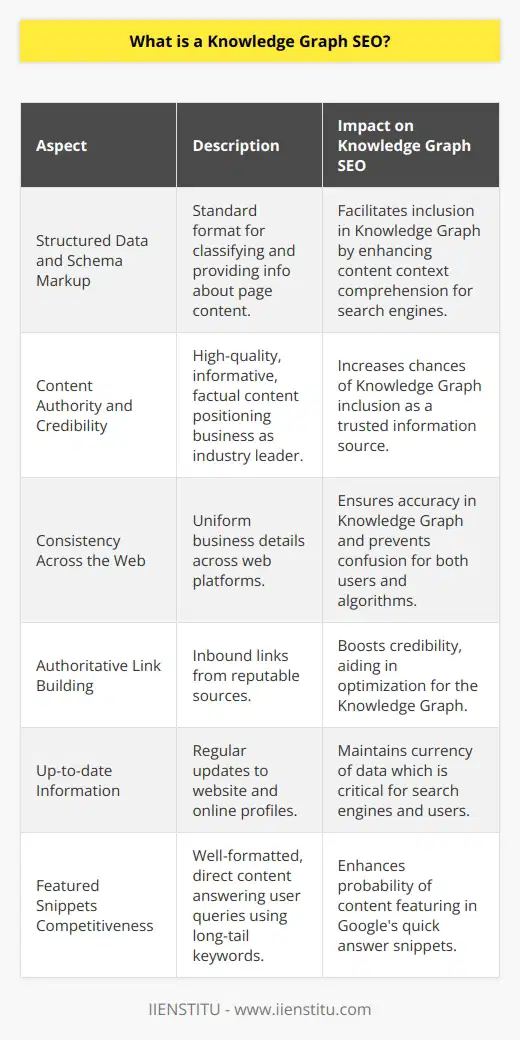
What are the key factors influencing the effectiveness of Knowledge Graph SEO?
Factors Influencing Knowledge Graph SEO
Search Engine Optimization (SEO) Techniques
The effectiveness of Knowledge Graph SEO is greatly influenced by the utilization of proper search engine optimization techniques. These techniques can include keyword research, link building, and creating high-quality, relevant content that attracts user traffic. By incorporating these methods, businesses can achieve a higher ranking on search engine result pages, leading to increased visibility in the Knowledge Graph.
Structured Data Markup
Another factor that impacts Knowledge Graph SEO is the utilization of structured data markup. By including this code in a website's HTML, search engines can better understand the content and context of a page, leading to more relevant knowledge graph cards being displayed. When implementing structured data, it is essential to follow the recommended guidelines to ensure the highest possible rankings.
Claiming and Optimizing Google My Business Profile
Claiming and optimizing one's Google My Business (GMB) profile is another crucial aspect of effective Knowledge Graph SEO. This helps search engines verify the legitimacy and relevance of a business, while also providing a wealth of information for potential customers. Ensuring accuracy and consistency in GMB profiles can improve search engine rankings and the likelihood of appearing in the Knowledge Graph.
Building Authority and Expertise
Establishing authority and expertise within a niche can greatly improve the efficacy of a company's Knowledge Graph SEO. This can involve producing high-quality content, gaining backlinks from reputable sources, and earning positive reviews on third-party websites. Businesses that are recognized as experts in their field are more likely to be featured in the Knowledge Graph, thus improving their online visibility.
Social Media Presence
A strong social media presence can also have a positive impact on Knowledge Graph SEO. This includes maintaining active profiles on various platforms, as well as engaging with users and sharing valuable content. By doing so, a business can build its brand awareness and authority, increasing the likelihood of being recognized as a leading source of information within its niche.
In conclusion, the effectiveness of Knowledge Graph SEO hinges on a combination of factors, including employing proper search engine optimization techniques, utilizing structured data markup, optimizing Google My Business profiles, establishing authority and expertise in a niche, and maintaining a robust social media presence. By focusing on these areas, businesses can significantly improve their chances of being featured in the Knowledge Graph, ultimately driving more traffic and potential customers to their website.

How can one assess the impact of Knowledge Graph implementation on a website's search visibility?
**Measuring the Impact of Knowledge Graph Implementation**
One way to assess the impact of Knowledge Graph implementation on a website's search visibility is by tracking the website's organic search traffic. This can be done by monitoring the number of website visitors originating from search engines, primarily through tools such as Google Analytics. An increase in organic search traffic after implementing the Knowledge Graph indicates improved search visibility.
**Examining Keyword Rankings**
Another approach to evaluate the effects of Knowledge Graph implementation involves analyzing the website's keyword rankings. Tools like Ahrefs and SEMrush can measure the positions of targeted keywords within search engine result pages (SERPs). Higher keyword rankings signify enhanced search visibility, which demonstrates the effectiveness of the Knowledge Graph strategy.
**Assessing Click-Through Rates**
A third metric to assess the impact of Knowledge Graph implementation is evaluating click-through rates (CTRs) for the website's search results. CTRs represent the proportion of searchers who click on the website's listing in the SERPs. An improvement in CTRs post-Knowledge Graph implementation may suggest that the additional information provided by the Knowledge Graph is attracting more users to the website.
**Analyzing Rich Snippet Inclusion**
The incorporation of rich snippets in a search result can be an indication of a successful Knowledge Graph implementation. Rich snippets, such as ratings, images, or additional text, increase the visibility and attractiveness of a search result. Monitoring the frequency of rich snippet inclusion in SERPs and the subsequent effects on search visibility might serve as a valuable method for measuring the impact of Knowledge Graph implementation.
**Evaluating Featured Snippet Presence**
Lastly, measuring the presence of the implemented Knowledge Graph information within featured snippets can also help assess its impact on search visibility. Featured snippets often present a concise answer to a user's question within a search result. Identifying prevalent Knowledge Graph content within featured snippets suggests a higher likelihood of website visibility and searcher engagement.
In conclusion, assessing the impact of Knowledge Graph implementation requires an examination of various metrics, such as organic search traffic, keyword rankings, click-through rates, rich snippet inclusion, and featured snippet presence. These metrics provide crucial insights into the effectiveness of Knowledge Graph strategies in enhancing a website's search visibility.
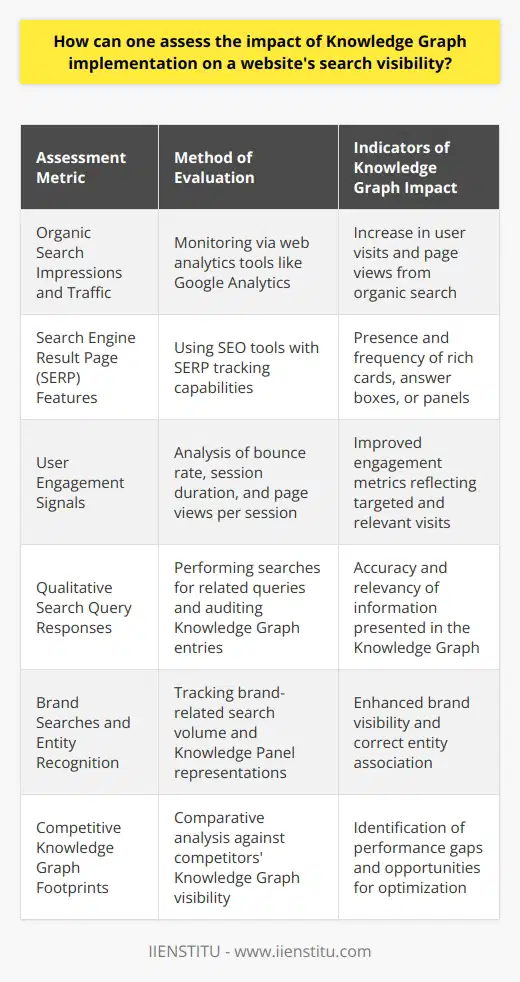
What strategies can be employed to keep a brand's information updated and relevant within the Google Knowledge Graph?
Monitoring and Updating Information
To ensure a brand's information remains updated and relevant within the Google Knowledge Graph, marketers must actively monitor and update their organization's digital presence. This encompasses keeping the brand's website, social media profiles, and Google My Business profile up-to-date. This strategy not only provides accurate information to users but also enhances the brand's visibility and credibility.
Leveraging Structured Data Markup
Utilizing structured data markup on a brand's website can significantly increase the likelihood of Google extracting accurate and relevant information to be displayed within the Knowledge Graph. By implementing schema.org markup, businesses can highlight specific information entities that may be essential in maintaining relevance in web search results, such as company logos, contact details, and customer reviews.
Actively Engaging on Google-owned Platforms
Engaging with customers on Google-owned platforms, such as Google My Business and YouTube, serves as a fruitful approach to enhancing a brand's online presence. Answering user questions on these platforms and updating the content published therein can help Google's search engine algorithms detect the brand's active online engagement, which will contribute to solidifying its relevance within the Knowledge Graph.
Monitoring and Addressing Online Reviews
Monitoring customer reviews on platforms like Google My Business and addressing their concerns can enhance a brand's online reputation. Positive reviews drive higher click-through rates, thereby improving the brand's relevance within the Google Knowledge Graph. By encouraging satisfied customers to share their experiences, brands can create an ecosystem of ongoing support and validation within the online community.
Establishing Authority through High-quality Content
Regularly publishing high-quality, authoritative content can help a brand gain prominence within the Google Knowledge Graph. By producing valuable content that aligns with current trends and customer expectations, brands can establish themselves as leading authorities in their respective industries, which Google rewards with higher search rankings and Knowledge Graph prominence. This strategy can be optimized through keyword research and search engine optimization tactics.
Collaborating with Industry Influencers
Collaborating with industry influencers and securing high-quality backlinks from reputable sources can boost a brand's authority, which translates into improved relevance within Google's Knowledge Graph. By fostering relationships with prominent industry figures, businesses can tap into new audiences and expand their digital reach, thereby maximizing their growth potential.

What is the role of schema markup in creating a successful Knowledge Graph for SEO?
Role of Schema Markup
Schema markup serves as a vital component in developing a successful Knowledge Graph for website SEO optimization. It is a semantic vocabulary of tags, which helps search engines comprehend and categorize website content better. As a structured data system, schema markup provides context to the content, improving its visibility and interpretability.
Enhancing Search Engine Understanding
The application of schema markup enables search engines to decipher the context and meaning behind the website content. This comprehension aids in matching user queries with relevant websites for improved search outcomes. Consequently, the search engine's enhanced understanding results in higher rankings on search engine results pages (SERPs) and greater organic traffic.
Facilitating Rich Snippets
Utilizing schema markup supports the formulation of rich snippets, which encompass additional information displayed under the website link in SERPs. These rich snippets can include customer ratings, event details, or any other relevant data, which not only attracts user attention but also projects the website's credibility. Moreover, rich snippets can effectively lead to higher click-through rates (CTR) and better user engagement.
Linking External Sources
Schema markup empowers the construction of a Knowledge Graph by bridging interconnected information from diverse sources. These connections provide a broader perspective and validate the website's content, boosting its credibility. Furthermore, these external source links fortify the search engine's understanding, refining the search results and enhancing website visibility.
Optimizing for Voice Search
With the advancement of voice assistants, optimizing for voice search has become a priority for website SEO. Schema markup facilitates voice assistants' understanding, allowing them to access and provide website information more efficiently and accurately. This optimization can significantly contribute to a website's prominence in voice search results, expanding its reach and accessibility.
In conclusion, schema markup plays a crucial role in creating a successful Knowledge Graph for SEO optimization. By enhancing search engine understanding, facilitating rich snippets, linking external sources, and optimizing for voice search, schema markup improves website visibility, credibility, and accessibility, ensuring its success in the competitive digital arena.
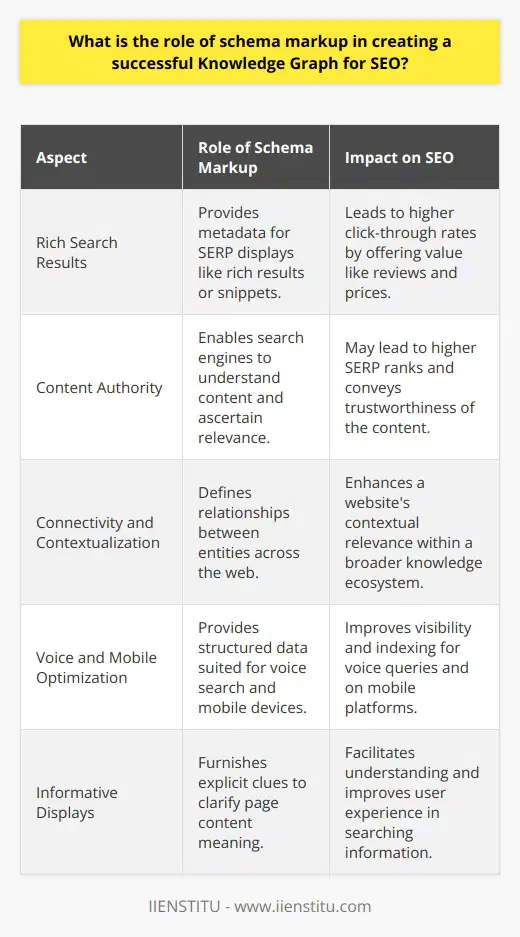
How can organizations ensure consistent and accurate information across various knowledge panels and platforms?
Establishing a Centralized Knowledge Management System
To ensure consistent and accurate information across various knowledge panels and platforms, organizations can implement a centralized knowledge management system. This system serves as a single source of truth for all the data and information needed by the company and its employees.
Developing Clear Guidelines and Processes
The foundation of a reliable knowledge management system is the implementation of clear guidelines and processes. Organizations should create standard operating procedures (SOPs) for employees to follow when creating, editing, and sharing information on different platforms. This reduces the risk of inconsistencies and inaccuracies, ensuring that all data is up-to-date and correct.
Promoting Active Collaboration and Communication
Organizations should encourage active collaboration and communication among employees, as this helps maintain the integrity of the knowledge management system. By fostering an environment where everyone contributes to the system's accuracy, companies can achieve high-quality outcomes and employees can work more efficiently and effectively.
Conducting Regular Audits and Reviews
Timely reviews and audits of the knowledge management system are important for the maintenance of consistency and accuracy. By conducting regular checks, organizations can identify any discrepancies and update the information accordingly, ensuring that all platforms display consistent data.
Implementing Automation Technologies
The use of automation technologies, like natural language processing (NLP) or artificial intelligence (AI), can help organizations improve the accuracy and consistency of their knowledge management system. These technologies can detect inaccuracies in real-time, enabling organizations to immediately rectify issues and maintain the system's reliability.
Providing Continuous Training and Support
Organizations should provide continuous training and support to employees, equipping them with the necessary knowledge and skills to maintain accurate information across platforms. Employees should be made aware of the importance of maintaining consistency and accuracy, and offered resources and tools to achieve this goal.
In conclusion, organizations can ensure consistency and accuracy across various knowledge panels and platforms by implementing a centralized knowledge management system, developing clear guidelines and processes, promoting active collaboration and communication, conducting regular audits and reviews, employing automation technologies, and providing continuous training and support to employees. By doing so, companies can maintain the integrity of their information systems while promoting efficiency and effectiveness in the workplace.

What are the essential steps in auditing and maintaining a website's Knowledge Graph information to optimize search engine performance?
**Understanding Knowledge Graph**
Auditing and maintaining a website's Knowledge Graph information involves a series of structured steps, aiming to optimize search engine performance. The Knowledge Graph, a database that allows search engines to display richer and more contextual information, helps improve user experience and webpage visibility.
**Assess Existing Knowledge Graph Information**
The first step involves assessing the existing Knowledge Graph information, which typically encompasses company details, social media profiles, logos, maps, and other relevant data. Webmasters can identify these entities through tools like Google's Structured Data Testing Tool and Schema.org guidelines to ensure compliance with best practices.
**Identifying Knowledge Gaps and Inconsistencies**
Once the existing data is evaluated, it is crucial to identify gaps and inconsistencies that may affect search engine rankings. These discrepancies can range from missing data types or properties to improper usage of schema markup. A thorough analysis highlights opportunities for improving content accuracy and search engine presentation.
**Implementation of Structured Data**
Incorporating structured data into a website's design is essential for maximizing Knowledge Graph benefits. Utilizing schema.org vocabularies, webmasters can include relevant metadata and context to HTML code and content. This addition effectively communicates the information to search engines, enabling a more transparent understanding of the underlying content and purpose.
**Monitor Updates and Changes**
Regular monitoring and maintenance of a website's Knowledge Graph information are crucial for long-term search engine performance optimization. Search engines frequently update their algorithms, requiring webmasters to adapt to maintain visibility and relevance in search results. Monitoring website changes can involve verifying code implementation, checking for broken links or outdated data, and staying current with search engine requirements.
**Measure Results and Iterate**
Finally, measuring the results of Knowledge Graph optimizations is key to understanding their impact on search engine rankings. Webmasters can use tools like Google Search Console, Bing Webmaster Tools, and other analytics platforms to track key performance indicators, such as organic search traffic, click-through rates, and keyword rankings. This data helps in evaluating the effectiveness of implemented strategies and identifying areas for further improvement.



